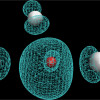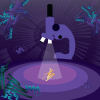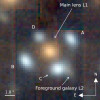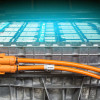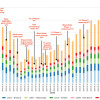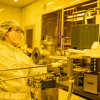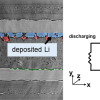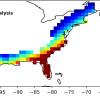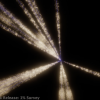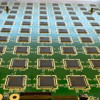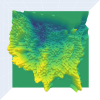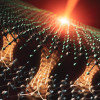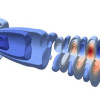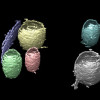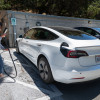Science News
Cori and Perlmutter Support New Understanding of Reaction Behind Salt-Based Nuclear Reactors
Using computing resources at NERSC, researchers have shown how electrons interact with ions of molten salts, providing insights into the processes that could occur inside next-generation salt-based nuclear reactors known as molten-salt reactors (MSRs). Read More »
NERSC Collaborations Help Illuminate Earth's Biodiversity
With the help of supercomputers at NERSC and support from the DOE's Exascale Computing Project, researchers in Berkeley Lab’s Applied Mathematics and Computational Research Division and at the Joint Genome Institute have developed new tools to advance the field of metagenomics and expand scientists’ understanding of our world’s biodiversity. Read More »
Perlmutter Supports First Gravitational Lensing System Modeled on GPUs
Using the GIGA-Lens modeling code on the Perlmutter supercomputer at NERSC, a team of researchers has modeled a rare instance of strong gravitational lensing known as an Einstein Cross—likely the first such system to be modeled on GPUs and a demonstration of the promise of GPU-accelerated modeling. Read More »
NERSC Assists in Search for More Sustainable EV Batteries
NERSC is helping a Berkeley Lab-led consortium of researchers speed the commercialization of a new family of batteries with more energy-dense cathodes that don’t require metals in short supply. Read More »
NERSC Helps Scientists Build Public Health Datasets from Location Services
Prompted by the COVID pandemic, scientists used NERSC resources to process location-based cell phone data and produce more detailed datasets that help them better estimate social contacts within public spaces. Read More »
How Scientists Are Accelerating Next-Gen Microelectronics
With the help of NERSC supercomputing resources and expertise, the newly launched Center for High Precision Patterning Science is developing a technique to pack over 100 billion transistors into a microchip the size of a fingernail. Read More »
NERSC Powers Insight Into Chemical Actuation of Self-Folding Origami Machines
3D microfabrication based on origami-inspired materials is a promising technique for building materials, structures, devices, and systems with unconventional electronic, mechanical, and optical properties. Read More »
Using Deep Learning to Assess Lithium Metal Battery Performance
A team of researchers from Berkeley Lab’s Center for Advanced Mathematics for Energy Research Applications and colleagues have developed batteryNET, a deep learning algorithm that enhances the assessment of lithium agglomeration in solid-state lithium metal batteries. Read More »
Three New Studies Emerge from NERSC Research on Climate Change, Extreme Weather
NERSC is a hub for climate and weather research, and three recent scientific journal articles all published within one month highlight the center’s continuing role in supporting this work. Read More »
DESI Early Data Release Holds Nearly Two Million Objects
NERSC makes the first batch of data from the Dark Energy Spectroscopic Instrument available for researchers to mine. Read More »
NERSC Supports First All-GPU Full-Scale Physics Simulation
Using supercomputers at NERSC, researchers have completed a simulation of a detector of neutrino interactions that’s designed to run exclusively on graphics processing units (GPUs)—the first simulation of its kind and an example of using GPUs’ highly parallel structure to process large amounts of physical data. Read More »
QIS Project Shows Novel Method for Privacy-Preserving Quantum ML
Scientific results from the initial QIS@Perlmutter projects are starting to emerge; in one recently published paper, a research group shared results of a quantum machine learning project that explores novel methods for preserving privacy within advanced quantum computing functions.
Read More »
Computational Modeling Streamlines Hunt for Battery Electrolytes
Using computing resources at NERSC at Berkeley Lab, researchers from the Joint Center for Energy Storage Research have identified new, more efficient ways to find improved electrolytes for batteries. By computationally modeling molecules and virtually observing their properties, researchers can identify the most promising ones and save experimental scientists from spending time and resources on those that won’t work. Read More »
New Math Methods and Perlmutter HPC Combine to Deliver Record-Breaking ML Algorithm
Using the Perlmutter supercomputer at the National Energy Research Scientific Computing Center (NERSC), researchers at Lawrence Berkeley National Laboratory (Berkeley Lab) have devised a new mathematical method for analyzing extremely large datasets – and, in the process, demonstrated proof of principle on a record-breaking dataset of more than five million points. Read More »
Shining a light on electrons’ role in energy transfer among 2D materials
Using the Cori supercomputer, a group of scientists examined heat and energy movements between certain 2D materials, spurring discoveries that could pave the way for a new generation of transistors Read More »
Berkeley Lab Works Toward a Connected Future for Science
Superfacility is a conceptual model of seamless connection between experimental facilities and high performance computing resources – an integrated and automated system for gathering, transporting, and analyzing scientific data in real time. Berkeley Lab is working to standardize, automate, and scale up the processes needed for superfacility onsite across the U.S. Department of Energy (DOE), and beyond. Read More »
The Most Advanced Bay Area Earthquake Simulations Will be Publicly Available
A collaboration involving scientists and computing resources from Berkeley Lab and the simulation software EQSIM is releasing the most accurate and detailed earthquake simulations to date, which will initially capture earthquake motions across the San Francisco Bay Area and later expand to other regions. Read More »
WarpX Code Shines at the Exascale Level
The WarpX project has spent the last six years creating a novel, highly parallel, and highly optimized single-source simulation code for modeling plasma-based particle colliders on cutting-edge exascale supercomputers, with broad importance for other accelerators and related problems. Read More »
Berkeley Lab Scientists Create Machine Learning Pipeline for Interpreting Large Tomography Datasets
A group of Berkeley Lab scientists has developed and tested several machine learning techniques organized in a learning pipeline to improve the interpretation of increasingly large cryo-ET datasets. Read More »
Perlmutter Results Show Progress in Quantum Information Science
The QIS@Perlmutter initiative at NERSC aims to support research in the space of quantum information science (QIS) conducted on the Perlmutter supercomputer, including quantum simulation of materials and chemical systems, algorithms for compilation of quantum circuits, error mitigation for quantum computing, and development of hybrid quantum/classical algorithms. The first phase of the project will come to an end this month, but has begun to bear fruit in the form of early science results and collaborations across the field. Read More »
New Search Method Expands Horizon in Hunt for New Polymer Electrolytes
Using computing resources at NERSC, researchers at MIT, in partnership with the Toyota Research Institute, have pioneered a new method for using machine learning to screen for new materials, yielding the largest dataset of polymer electrolytes ever seen in the field and signaling progress for the search for new materials generally. Read More »






